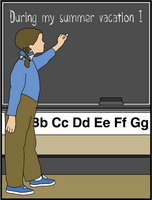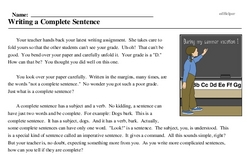Writing a Complete Sentence
Your teacher hands back your latest writing assignment. She takes care to fold yours so that the other students can't see your grade. Uh-oh! That can't be good. You bend over your paper and carefully unfold it. Your grade is a "D." How can that be? You thought you did well on this one.
You look over your paper carefully. Written in the margins, many times, are the words "not a complete sentence." No wonder you got such a poor grade. Just what is a complete sentence?
A complete sentence has a subject and a verb. No kidding, a sentence can have just two words and be complete. For example: Dogs bark. This is a complete sentence. It has a subject, dogs. And it has a verb, bark. Actually, some complete sentences can have only one word. "Look!" is a sentence. The subject, you, is understood. This is a special kind of sentence called an imperative sentence. It gives a command. All this sounds simple, right? But your teacher is, no doubt, expecting something more from you. As you write more complicated sentences, how can you tell if they are complete?




